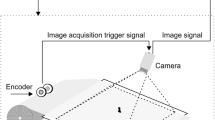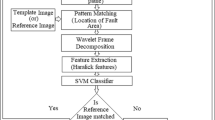Abstract
This paper focus on the classification, in real-time and under uncontrolled lighting, of fabric textures for the automotive industry. Many industrial processes have spatial constraints that limit the effective control of illumination of their vision based systems, hindering their effectiveness. The ability to overcome these problems using robust classification methods with suitable pre-processing techniques and choice of characteristics will increase the efficiency of this type of solutions with obvious production gains and thus economical. For this purpose, this paper studied and analyzed various pre-processing techniques, and selected the most appropriate fabric characteristics for the considered industrial case scenario. The methodology followed was based on the comparison of two different machine learning classifiers, ANN and SVM, using a large set of samples with a large variability of lightning conditions to faithfully simulate the industrial environment. The obtained solution shows the sensibility of ANN over SVM considering the number of features and the size of the training set, showing the better effectiveness and robustness of the last. The characteristics vector uses histogram equalization, Laws filter and Sobel filter, and multi-scale analysis. By using a correlation based method was possible to reduce the number of features used, achieving a better balanced between processing time and classification ratio.















Similar content being viewed by others
References
AForge.NET: Computer Vision, Artificial Intelligence, Robotics [Internet]. [cited January 7, 2014]. Available from http://www.aforgenet.com/.
Ahmed, S. A., Dey, S., & Sarma, K. K. (2011). Image texture classification using artificial neural network (ANN). In 2011 2nd national conference on emerging trends and applications in computer science (NCETACS) (p. 14).
Aksoy, M. S., Torkul, O., & Cedimoglu, I. H. A. (2004). An industrial visual inspection system that uses inductive learning. Journal of Intelligent Manufacturing, 15, 569–574.
Aleksander, I., & Morton, H. (1990). An introduction to neural computing (Vol. 3). London: Chapman and Hall.
Arun, D. K. (1993). Artificial neural networks for image understanding (1st ed.). New York, NY: Wiley.
Ballard, D. H., & Brown, C. M. (1982). Computer vision. London: Prentice-Hall.
Ben Salem, Y., & Nasri, S. (2010). Automatic recognition of woven fabrics based on texture and using SVM (pp. 429–434). Image and Video Processing: Journal Signal.
Brosnan, T., & Sun, D.-W. (2004). Improving quality inspection of food products by computer visiona review. Journal of Food Engineering, 61(1), 3–16.
Burges, C. J. C. (1998). A tutorial on support vector machines for pattern recognition. Data Mining and Knowledge Discovery, 2, 121–167. doi:10.1023/A:1009715923555.
Burt, P. J., & Adelson, E. H. (1983). The Laplacian pyramid as a compact image code. IEEE Transactions on Communications, 31(4), 53240.
Fellows, P. J. (2009). In P. J. Fellows (Eds.), Woodhead publishing series in food science, technology and nutrition (3rd edn, pp. 1–8). Woodhead Publishing, Food Processing Technology. ISBN 9781845692162. doi:10.1533/9781845696344.1.
Ghorai, S., Mukherjee, A., Gangadaran, M., & Dutta, P. K. (2013). Automatic defect detection on hot-rolled flat steel products. IEEE Transactions on Instrumentation and Measurement, 62(3), 612–621.
Gonzalez, R. C., & Woods, R. E. (2006). Digital image processing. Upper Saddle River, NJ: Prentice-Hall.
Haralick, R. M., Shanmugam, K., & Dinstein (1973). Its’Hak, “Textural features for image classification”. IEEE Transactions on Systems, Man and Cybernetics, SMC-3(6), 610–621.
Hosseini, S., Al Khaled, A., & Vadlamani, S. (2014). Hybrid imperialist competitive algorithm, variable neighborhood search, and simulated annealing for dynamic facility layout problem. Neural Computing and Applications, 25(7–8), 1871–1885.
Jeon, B. S., Bae, J. H., & Suh, M. W. (2013). Automatic recognition of woven fabric patterns by an artificial neural network. Textile Research Journal, 73(7), 645–650. doi:10.1177/004051750307300714.
Kotsiantis, S. B. (2007). Supervised machine learning: A review of classification techniques. In Maglogiannis, I., Karpouzis, K., Wallace, M., & Soldatos, J. (Eds.), Proceedings of the 2007 conference on emerging artificial intelligence applications in computer engineering: Real word AI systems with applications in eHealth, HCI, information retrieval and pervasive technologies (pp. 3–24). Amsterdam, The Netherlands: I.O.S. Press.
Kwak, C., Ventura, J. A., & Tofang-Sazi, K. (2000). A neural network approach for defect identification and classification on leather fabric. Journal of Intelligent Manufacturing, 11, 485–499.
Laws, K. I. (2014). Textured image segmentation. Ph.D. Thesis, University of Southern California Los Angels Image Processing Institute [cited January 4, 2014]. Available from http://www.dtic.mil/docs/citations/ADA083283.
Li, S., Kwok, J. T., Zhu, H., & Wang, Y. (2003). Texture classification using the support vector machines. Pattern Recognition, 36(12), 288393.
Loke, K.S. (2009). An approach to textile recognition, pattern recognition. In P.-Y. Yan (Ed.), ISBN: 978-953-307-014-8, InTech, doi:10.5772/7531. Available from http://www.intechopen.com/books/pattern-recognition/an-approach-to-textile-recognition.
MVTec HALCON 10—Highlights of version 10 [Internet]. [cited January 7, 2014]. Available from http://www.halcon.com/halcon/version10/.
Ojala, T., Pietikinen, M., & Nisula, J. (1996). Determining composition of grain mixtures by texture classification based on feature distributions. International Journal of Pattern Recognition and Artificial Intelligence, 10, 7382.
Palm, C. (2004). Color texture classification by integrative co-occurrence matrices. Pattern Recognition, 37(5), 965–976.
Pavelka, A. P., & Procházka, P. (2004). Algorithms for initialization of neural network weights. Tech Comput: Proc. Conf.
Pinto, N., Cox, D. D., & DiCarlo, J. J. (2008). Why is real-world visual object recognition hard? PLoS Comput Biol, 4(1), e27. doi:10.1371/journal.pcbi.0040027.
Pinto, A. M., Rocha, L. F., & Moreira, A. P. (2013). Object recognition using laser range finder and machine learning techniques. Robotics and Computer-Integrated Manufacturing, 29(1), 1222.
Rocha, L. F., Malaca, P., Silva, J., Moreira, A. P., & Veiga, G. (2015). Development of a 3D model based part recognition system for industrial applications. In 2015 IEEE international conference on main challenges, industrial technology (ICIT) (pp. 3296–3301).
Rocha, L. F., Ferreira, M., Santos, V., & Moreira, A. P. (2014). Object recognition and pose estimation for industrial applications: A cascade system. Robotics and Computer-Integrated Manufacturing, 30(6), 605–621.
Sanders, D., Lambert, G., Pevy, L., & Tewkesbury, G. (2009). Improving robotic welding in the shipbuilding industry through the recognition of ship-building parts by pre-locating corners in images. Budapest; 2009 [cited January 7, 2014]. Available from http://eprints.port.ac.uk/5305.
Schwartz, W. R., & Pedrini, H. (2007). Color textured image segmentation based on spatial dependence using 3D co-occurrence matrices and markov random fields. In 15th international conference in Central Europe on computer graphics, visualization and computer vision, Plzen, Czech Republic (pp. 81–87).
Sharma, M., & Singh, S. (2001). Evaluation of texture methods for image analysis. Intelligent Information Systems Conference, The Seventh Australian and New Zealand, 2001, 11721.
Shenbagavalli, R., & Ramar, K. (2011). Classification of soil textures based on laws features extracted from preprocessing images on sequential and random windows. Bonfring International Journal of Advances in Image Processing, 1, 15–18.
Theodoridis, S., & Koutroumbas, K. (2009). Pattern recognition (4th ed.). Boston, MA: Academic Press.
Veiga, G., Silva, C., Arajo, R., Pires, N., & Siciliano, B. (2013). The ECHORD project proposals analysis Research profiles, collaboration patterns and research topic trends. Expert System with Applications, 40(17), 713240.
Author information
Authors and Affiliations
Corresponding author
Rights and permissions
About this article
Cite this article
Malaca, P., Rocha, L.F., Gomes, D. et al. Online inspection system based on machine learning techniques: real case study of fabric textures classification for the automotive industry. J Intell Manuf 30, 351–361 (2019). https://doi.org/10.1007/s10845-016-1254-6
Received:
Accepted:
Published:
Issue Date:
DOI: https://doi.org/10.1007/s10845-016-1254-6




